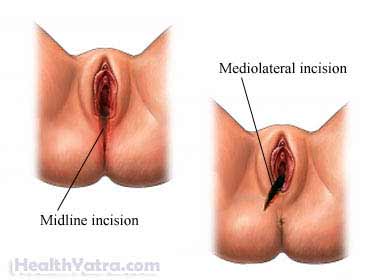Definition
The perineum is the area between the vagina and the anus. It is made up of skin and muscle. During an episiotomy, an incision is made in the perineum.
Reasons for Procedure
The incision is made to make the vaginal opening larger during birth. In the past, this incision was common. But it is no longer routinely done.
Your doctor may do an episiotomy if:
- The baby is:
- Premature or otherwise fragile
- Large and the shoulders may be hard to deliver
- Forceps or a vacuum are needed to assist in the delivery
Possible Complications
Some short-term complications may include:
- Bleeding
- Infection
- Bruising
- Swelling
- Difficulty controlling your bowels
Factors that may increase the risk of complications include:
- Severe scar tissue in the area
- Prior problems with chronic pain in the vulva
- Short perineum
What to Expect
Prior to Procedure
During a prenatal visit, talk to your doctor about the benefits and risks of an episiotomy.
Anesthesia
If you have not had epidural anesthesia during labor, the doctor may use local orregional anesthesia.
Description of the Procedure
The infant’s head will start to stretch the vaginal opening. The doctor will then use special scissors to make an incision in the perineum area.
There are two different incisions that may be used:
- Midline incision: starts at the vagina and follows a straight line to the anus
- Mediolateral: starts at the vagina and continues at an angle

After delivery of the baby and placenta, your doctor will close the incision with absorbable stitches.
How Long Will It Take?
This is done during childbirth.
Will It Hurt?
If you receive anesthesia, you will not feel pain during the procedure. After delivery, most women have discomfort and swelling. You may need to take pain medicine.
Average Hospital Stay
The usual length of stay for vaginal delivery is two days. An episiotomy will not extend your stay.
Postoperative Care
Your stitches will dissolve in about 10 days. The cut will heal within about two weeks. There may still be some soreness until the skin gets its natural strength back. This could take up to six weeks. During that time, you may find it uncomfortable to sit or walk. Ways to care for your perineum include:
- For the first 24 hours after delivery, apply ice. Wrap the ice in a towel. Do not apply it directly to your skin.
- Ask your doctor about when it is safe to shower, bathe, or soak in water.
- When your doctor says it is okay, take a sitz bath several times each day. This involves immersing your hips and buttocks in water. Cool water may help to relieve discomfort.
- Do not strain when moving your bowels. Your doctor may ask you to take a laxative or stool softener.
- Use a spray bottle of water to clean the area after going to the bathroom.
- Use spray, medicated pads, or medicine as directed by your doctor.
- When your doctor tells you to, do Kegel exercises. Simply squeeze the muscles you use to stop the flow of urine. This strengthens the pelvic floor and can help the area heal faster.
- Avoid having sex, douching, and using tampons for six weeks or as directed by your doctor.
- Be sure to follow your doctor’s instructions.
Call Your Doctor
After arriving home, contact your doctor if any of the following occur:
- Signs of infection, including fever and chills, swelling, redness, foul-smelling discharge
- Pain that you cannot control with the medicines you have been given
- Bleeding from the episiotomy site
- Continuing problems with loss of urinary or bowel control
In case of an emergency, call for medical help right away.
